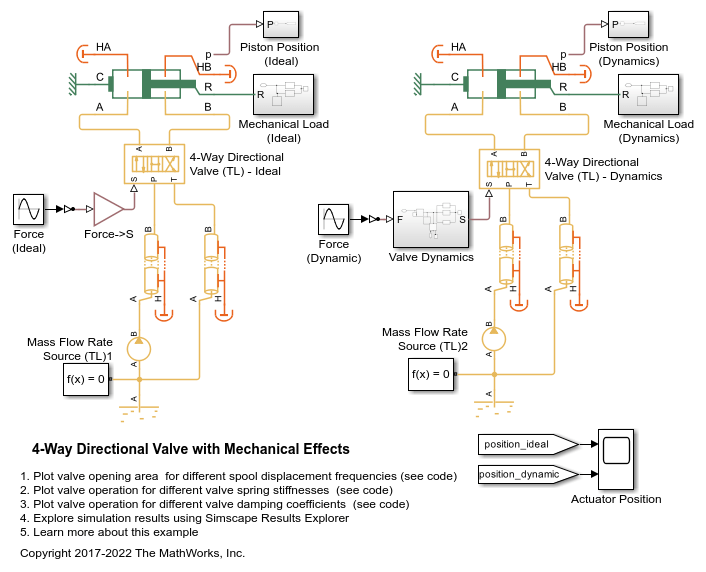Valves and Orifices
Use these blocks to model orifices, valves, valve actuators, and forces associated with valves and orifices in the thermal liquid domain.
Simscape Blocks
Fundamental Valve Components
| Flow Coefficient Parameterized Valve (TL) | Valve with flow area modeled in terms of its Cv or Kv flow coefficient |
| Orifice (TL) | Constant-area or variable-area orifice in a thermal liquid system (Since R2022a) |
Directional Control Valves
| 2-Way Directional Valve (TL) | 2-way directional valve in a thermal liquid network |
| 3-Way Directional Valve (TL) | 3-position directional valve in a thermal liquid network |
| 4-Way 2-Position Directional Valve (TL) | 4-way 2-position directional valve in a thermal liquid network (Since R2024a) |
| 4-Way 3-Position Directional Valve (TL) | Valve for routing flow at the junction of four lines in a thermal liquid network |
| Check Valve (TL) | Valve for the prevention of flow aimed counter to its intended direction |
| Pilot-Operated Check Valve (TL) | Check valve with control port to enable flow in reverse direction |
Flow Control Valves
| Poppet Valve (TL) | Poppet flow control valve in a thermal liquid network |
| Gate Valve (TL) | Gate valve in a thermal liquid system |
| Temperature Control Valve (TL) | Temperature control valve in a thermal liquid network |
Pressure Control Valves
| Pressure Reducing Valve (TL) | Pressure reducing valve in a thermal liquid network |
| Pressure Relief Valve (TL) | Pressure relief valve in a thermal liquid network |
| Pressure Compensator Valve (TL) | Pressure compensator valve in thermal liquid network (Since R2023a) |
Valve Actuators and Forces
| Multiposition Valve Actuator | Multiposition actuator in any fluid domain (Since R2020a) |
| Proportional Valve Actuator | Power-controlled valve actuator in any fluid domain (Since R2020a) |
Topics
- Modeling Valves in Simscape Fluids
Selecting and parameterizing valves in Simscape Fluids.
- Building a Custom Valve
Model a custom valve with orifice blocks.
- Model a Refrigeration Cycle
Model considerations for a closed-loop refrigeration cycle.
Featured Examples
MATLAB Command
You clicked a link that corresponds to this MATLAB command:
Run the command by entering it in the MATLAB Command Window. Web browsers do not support MATLAB commands.

Select a Web Site
Choose a web site to get translated content where available and see local events and offers. Based on your location, we recommend that you select: .
You can also select a web site from the following list:
How to Get Best Site Performance
Select the China site (in Chinese or English) for best site performance. Other MathWorks country sites are not optimized for visits from your location.
Americas
- América Latina (Español)
- Canada (English)
- United States (English)
Europe
- Belgium (English)
- Denmark (English)
- Deutschland (Deutsch)
- España (Español)
- Finland (English)
- France (Français)
- Ireland (English)
- Italia (Italiano)
- Luxembourg (English)
- Netherlands (English)
- Norway (English)
- Österreich (Deutsch)
- Portugal (English)
- Sweden (English)
- Switzerland
- United Kingdom (English)








